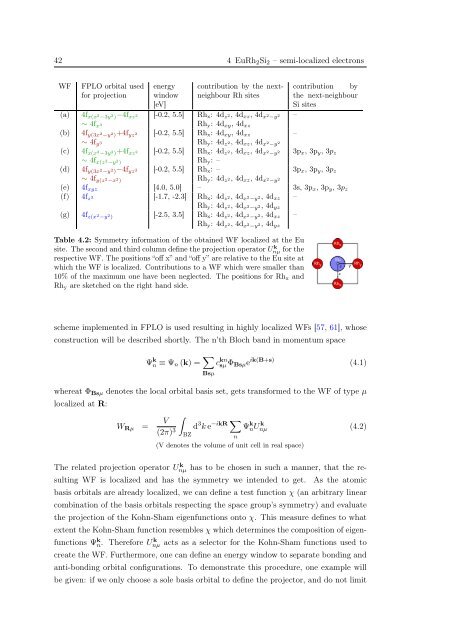Diploma - Max Planck Institute for Solid State Research
Diploma - Max Planck Institute for Solid State Research
Diploma - Max Planck Institute for Solid State Research
Create successful ePaper yourself
Turn your PDF publications into a flip-book with our unique Google optimized e-Paper software.
42 4 EuRh 2 Si 2 – semi-localized electrons<br />
–<br />
–<br />
WF FPLO orbital used energy contribution by the nextneighbour<br />
contribution by<br />
<strong>for</strong> projection window<br />
[eV]<br />
Rh sites the next-neighbour<br />
Si sites<br />
(a) 4f x(x 2 −3y 2 )−4f xz 2 [-0.2, 5.5] Rh x : 4d z 2, 4d xz , 4d x2 −y 2<br />
∼ 4f x 3<br />
Rh y : 4d xy , 4d xz<br />
(b) 4f y(3x2 −y 2 )+4f yz 2 [-0.2, 5.5] Rh x : 4d xy , 4d xz<br />
∼ 4f y 3<br />
Rh y : 4d z 2, 4d xz , 4d x 2 −y 2<br />
(c) 4f x(x 2 −3y 2 )+4f xz 2 [-0.2, 5.5] Rh x : 4d z 2, 4d xz , 4d x 2 −y 2 3p x , 3p y , 3p z<br />
∼ 4f x(z 2 −y 2 )<br />
Rh y : –<br />
(d) 4f y(3x 2 −y 2 )−4f yz 2 [-0.2, 5.5] Rh x : –<br />
3p x , 3p y , 3p z<br />
∼ 4f y(z2 −x 2 )<br />
Rh y : 4d z 2, 4d xz , 4d x2 −y 2<br />
(e) 4f xyz [4.0, 5.0] – 3s, 3p x , 3p y , 3p z<br />
(f) 4f z 3 [-1.7, -2.3] Rh x : 4d z 2, 4d x 2 −y 2, 4d xz –<br />
Rh y : 4d z 2, 4d x 2 −y 2, 4d yz<br />
(g) 4f z(x 2 −y 2 ) [-2.5, 3.5] Rh x : 4d z 2, 4d x2 −y 2, 4d xz<br />
Rh y : 4d z 2, 4d x2 −y 2, 4d yz<br />
–<br />
Table 4.2: Symmetry in<strong>for</strong>mation of the obtained WF localized at the Eu<br />
site. The second and third column define the projection operator U k nµ <strong>for</strong> the<br />
respective WF. The positions “off x” and “off y” are relative to the Eu site at<br />
which the WF is localized. Contributions to a WF which were smaller than<br />
10% of the maximum one have been neglected. The positions <strong>for</strong> Rh x and<br />
Rh y are sketched on the right hand side.<br />
scheme implemented in FPLO is used resulting in highly localized WFs [57, 61], whose<br />
construction will be described shortly. The n’th Bloch band in momentum space<br />
Ψ k n ≡ Ψ n (k) = ∑ Bsµ<br />
c kn<br />
sµ Φ Bsµ e ik(B+s) (4.1)<br />
whereat Φ Bsµ denotes the local orbital basis set, gets trans<strong>for</strong>med to the WF of type µ<br />
localized at R:<br />
W Rµ =<br />
V<br />
(2π)<br />
∫BZ<br />
3 d 3 k e ∑ −ikR Ψ k nUnµ k (4.2)<br />
n<br />
(V denotes the volume of unit cell in real space)<br />
The related projection operator Unµ k has to be chosen in such a manner, that the resulting<br />
WF is localized and has the symmetry we intended to get. As the atomic<br />
basis orbitals are already localized, we can define a test function χ (an arbitrary linear<br />
combination of the basis orbitals respecting the space group’s symmetry) and evaluate<br />
the projection of the Kohn-Sham eigenfunctions onto χ. This measure defines to what<br />
extent the Kohn-Sham function resembles χ which determines the composition of eigenfunctions<br />
Ψ k n. There<strong>for</strong>e Unµ k acts as a selector <strong>for</strong> the Kohn-Sham functions used to<br />
create the WF. Furthermore, one can define an energy window to separate bonding and<br />
anti-bonding orbital configurations. To demonstrate this procedure, one example will<br />
be given: if we only choose a sole basis orbital to define the projector, and do not limit
















